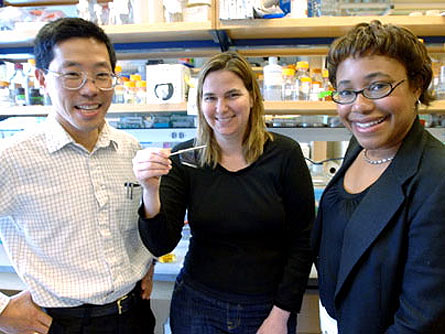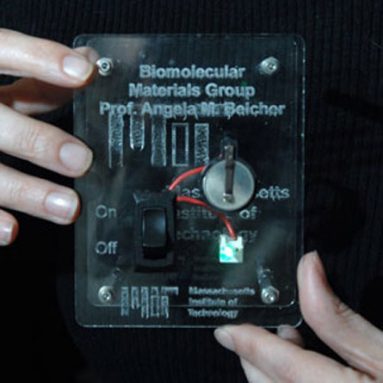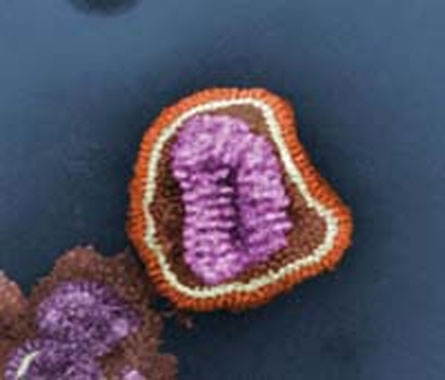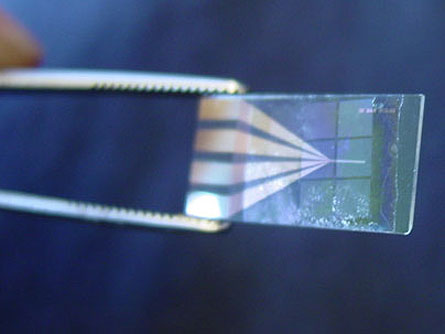Batteries built by viruses
Scientists use microbes to create tiny power supplies
 |
|
Why are these scientists smiling? Professors Yet-Ming Chiang, Angela Belcher and Paula Hammond from MIT proudly stand with a battery-building virus they have engineered. The virus is on a glass slide held by Belcher, center. |
| Donna Coveney, MIT |
What do chicken pox, the common cold, the flu, and AIDS have in common? They’re all diseases caused by viruses, tiny microorganisms that can pass from person to person. It’s no wonder that when most people think about viruses, finding ways to steer clear of viruses is what’s on people’s minds.
Not everyone runs from the tiny disease carriers, though. In Cambridge, Massachusetts, scientists have discovered that some viruses can be helpful in an unusual way. They are putting viruses to work, teaching them to build some of the world’s smallest rechargeable batteries.
Viruses and batteries may seem like an unusual pair, but they’re not so strange for engineer Angela Belcher, who first came up with the idea. At the Massachusetts Institute of Technology (MIT) in Cambridge, she and her collaborators bring together different areas of science in new ways. In the case of the virus-built batteries, the scientists combine what they know about biology (the study of living things), technology and production techniques.
Belcher’s team includes Paula Hammond, who helps put together the tiny batteries, and Yet-Ming Chiang, an expert on how to store energy in the form of a battery. “We’re working on things we traditionally don’t associate with nature,” says Hammond.
 |
|
Professor Angela Belcher shows off the virus-built battery she helped engineer. The battery — the silver-colored disk on the right side of the device — is being used to power an LED. |
| Donna Coveney/MIT |
Many batteries are already pretty small. You can hold A, C and D batteries in your hand and the coin-like batteries that power watches are often smaller than a penny. However, every year, new electronic devices like personal music players or cell phones get smaller than the year before. As these devices shrink, ordinary batteries won’t be small enough to fit inside.
The ideal battery will store a lot of energy in a small package. Right now, Belcher’s model battery, a metallic disk completely built by viruses, looks like a regular watch battery. But inside, its components are very small—so tiny you can only see them with a powerful microscope.
How small are these battery parts? To get some idea of the size, pluck one hair from your head (unless that seems too painful). Place your hair on a piece of white paper and try to see how wide your hair is—pretty thin, right? Although the width of each person’s hair is a bit different, you could probably fit about 10 of these virus-built battery parts, side to side, across one hair. These microbatteries (“micro” means very small) may change the way we look at viruses.
Slimy liquids that pack a punch
The word “virus” comes from a Latin word that means “poison” or “slimy liquid.” Each virus has a name, and the virus used by Belcher and her team is called M13. To humans, the M13 virus is actually harmless. The virus only infects bacteria. Under a powerful microscope, the M13 virus looks like a thread.
A virus usually has two main parts: a shell and genetic material, molecules called nucleic acid, inside the shell. You can think of nucleic acid (which can be DNA or RNA, depending on the virus) as a recipe that tells the virus what to do. Every living cell has a recipe inside—the genetic material inside you, for example, tells your cells how to keep you alive and functioning.
A virus is like a switch. When a virus is by itself, it cannot do anything—it is switched off. Its genetic recipe sits quietly. The virus cannot reproduce, spread or do any harm. A virus becomes harmful only when it gets inside the cell of a living organism—at this moment it switches “on.” For example, if you look at the chicken pox virus under a microscope, it can’t hurt you. But if the virus finds its way into your body, look out—and try not to scratch.
 |
|
You won’t see it coming: When the genetic material inside this influenza virus gets into your cells, you get the flu. This picture was taken with a powerful microscope. |
| CDC/ Dr. Erskine. L. Palmer; Dr. M. L. Martin |
When a virus attacks a cell, the virus injects its genetic material inside. The viral genetic material takes over the cell, pushing aside the instructions from the cell’s own genetic material. Instead of doing its normal functions, the cell starts to make copies of the virus. In other words, the virus cannot reproduce itself, but it can turn a living cell into a virus-making factory. These new virus particles can break out of the cell and go on to attack other cells. Those cells may make more virus particles. An infection is born.
Viruses only function inside another cell, so are viruses alive? Scientists have debated this question for decades, and your answer depends on how you define “alive.” On one hand, you might say that something is alive because it has genetic material. Human beings and animals, for example, have genetic material. Rocks do not. On the other hand, if you say that something is alive only if it is able to reproduce and store energy, then viruses are not alive because they need hosts. They’re on the line between living and nonliving things in the world—more like zombies than living organisms!
Changing the recipe
Remember that when a virus invades a cell, it forces the cell to start making new virus particles. At MIT, the scientists are turning that relationship on its head. Belcher and her team are able to go inside the virus and change its genetic recipe. With these changes, the scientists turn the tiny foe into a useful friend.
Instead of attacking other cells, the altered virus does something no natural virus would do: It starts to collect little bits of metal on its shell. Soon the virus is covered by a tiny suit of armor. Underneath the metal, the virus is still there. Belcher likens the virus to a scaffolding—the support structure you might see outside a building that is under construction. The virus provides the structure, giving form to the metal parts while the parts are being put together.
 |
|
The slide in this picture contains the electronic circuitry that Belcher used to test her virus-built battery. The battery is so small you can’t see it, but it’s there. |
| Belcher Laboratory, MIT |
“The virus remains intact, but is completely covered,” Belcher says.
This metal structure plays an important part in the battery. After the battery charges and discharges, she says, the virus itself may break down, but the metal structure will remain.
A battery is made of three main parts: two electrodes and an electrolyte. Electrodes are pieces of metal with electric charges, and an electrolyte is a material between them. You might think of a battery as a peanut butter sandwich, where the metal electrodes are like the bread and the peanut butter is the electrolyte. (For more information, see What is a Battery? below.)
The metal collected by the virus can be used as an electrode. In 2006, the team built only one electrode, but their research has advanced quickly since then. “We have the materials where we can make the full microbattery now as well,” Belcher says. Last year, together with Hammond and Chiang, she showed how the virus-built electrodes can be produced quickly and cheaply, without toxic chemicals. And earlier this year, with another team of engineers, she helped design the other electrode. When Belcher’s team tested the new, complete battery in the laboratory, it performed as well as other rechargeable batteries.
The microbatteries could be used to power a wide variety of tiny electronic devices. “Because [the batteries] are very small, they can be implemented into anything that involves microfabrication,” says Hammond.
In addition to the ever-shrinking world of electronics, the batteries may also play a role in the search for alternative energy sources. One reason we don’t see more electric vehicles on the road is that they require many heavy batteries to operate. If Belcher, Hammond and Chiang’s work is any indication, then lighter, more efficient batteries aren’t too far away. Just think—the batteries in your car may one day be built with help from a virus!
Going Deeper:
Angela Belcher and her team are currently trying to teach viruses to build new solar cells. To keep up with the latest from her lab at MIT, go to http://belcher10.mit.edu/
Paula Hammond’s research group puts together some of the smallest things in the world: http://web.mit.edu/hammond/lab/
Yet-Ming Chiang’s batteries are making the world a greener place: http://web.mit.edu/INVENT/iow/ychiang.html







